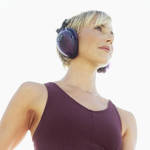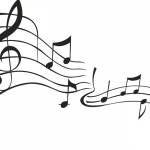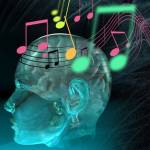Adam Curtis at the BBC blog gives us two identical video clips set to very different music.
Listen to some of each clip to see whether you experience what Curtis suggests.
About the first clip, Curtis says, “I think it gives a sense that we are all together in the dance.” I agree.
But the second clip is different. Curtis says, “The feeling it evokes is how separate we are — and how isolated we sometimes are from one another.” Yes.
Same video, yet very different experiences. How does the music do this?
Here’s how it works with me. In the first clip, the music’s beat and tone matches the dancers’. Both are upbeat, energetic, happy. The music makes me, the listener, feel upbeat, and I see the dancers being upbeat, and the integration of what I am seeing and hearing makes me feel connected and a part of the dancers’ experience.
But in the second clip, what the dancers are doing and feeling is disconnected from the music. The dancers are fast-moving and having fun while the music is melancholy, slow-paced, and often out-of-beat with dancers’ movements. The music makes me feel melancholy but I am seeing other people having fun, so the music and visuals are divergent, so I feel as though I am seeing the dancers from a distance, or through a telescoping or slightly distorting medium. Additionally, the mismatch of the visual and auditory beats reinforces the disconnection.
Analogy: While walking home from a funeral, feeling saddened and contemplative and with solemn music in your head, you pass by a playground with kids running around and shrieking joyously, lovers holding hands, a family having a picnic. You see fun, but you don’t feel fun, so you feel disconnect.
Overall music-video experience arises from the integration/dis-integration of compounded elements:  (1) What I see in the video, (2) what I feel from the music, and (3) the relation of the video to the music.
(1) What I see in the video, (2) what I feel from the music, and (3) the relation of the video to the music.
But (1) and (2) are themselves compound:
* In the video I see rhythmic movement, and I see and interpret facial expressions and body language. The seeing and interpreting lead to an emotion.
* In the music I hear rhythm and expressive tone and that leads to an emotion.
The visual experience is the integration of several elements, as is the musical experience, and each leads to an emotional judgment — and the overall music-video experience depends on whether the juxtaposition of the visually-based package and the auditorily-based package integrates or mis-integrates. Their integration causes a feeling of connection; their mis-integration leads to a feeling of disconnection.
How is that as a start? Amazing that so much goes on experientially, and that it occurs so quickly and automatically.
Great analysis!!! I would only add that, in my opinion, the music is more powerful in creating the emotions… it determines what you feel toward the content of the video. The video determines the content (it’s more intellectual than the music), and the music tells you what you feel about that content. So if the images are happy, but the music tells you that you are sad.. than you conclude that you’re depressed, unable to connect to that happiness for some reason (the people in the video died, or you’re coming from a funeral, like you said).. But if the images were violent for instance, and the music was upbeat (like in a Tarantino movie), you would feel a little evil or sadistic.. because you’re having fun while people are dying.. like the character in A Clockwork Orange..
Nicely stated, Caio. I especially like your Tarantino/Clockwork example.